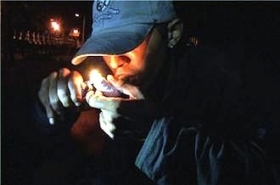While crack cocaine has declined in popularity in the U.S., its use is increasing in Latin America, spreading to non-coca producing countries like Brazil and Argentina.
These countries are increasingly becoming drug consumers as well as transit points for traffickers. According to the UN Office on Drugs and Crime, Argentina accounts for 25 percent of the cocaine use in Latin America and the Caribbean, while Brazil accounts for a third of all use in the region, and Chile for a further 10 percent.
Part of this new drug consumption is driven by cheap cocaine by products like crack. Variations of this drug are known by different names across the region, such as “paco” in Argentina and Uruguay, “merla” in Brazil, and “basuco” in Colombia.
As the Associated Press noted in a recent report on the phenomenon, the amount of crack cocaine seized by police in São Paulo, Brazil more than doubled from 2006 to 2009, and 98 percent of its states have registered crack cocaine traffic or consumption. In Argentina, crack now dominates drug sales on the streets of Buenos Aires, according to some reports. Argentina’s population of drug users is estimated to have doubled since 2007, partly due to crack’s appearance on the scene.
It has been suggested that the rise in crack consumption in the southern-most part of South America could be the result of strong anti-drug policies in the traditional cocaine producing countries in the Andes. The tightening of restrictions on precursor chemicals in countries like Colombia and Peru, along with general security improvements, has forced sellers to find new, more accessible production locations. This creates a “balloon effect,” pushing the cocaine manufacturing process south into this part of the region. The UN points to the Bolivian need for a new market for its coca paste, which used to go to Colombia for processing. When Colombia increased air security, and its production of coca, Brazilian trafficking groups began to purchase more Bolivian coca paste to refine in their country. Where cocaine is refined, it is profitable to create a local market for the by-product of this process — crack.
Brazil is a key transit country for drugs from the Andes region being shipped to Europe and Africa. The policing of the countries’ borders has historically been problematic; it shares borders with 10 countries, including Colombia, Peru, and Bolivia. The State Department estimates that most of the Bolivian coca products (which are often of lower quality) entering Brazil are consumed there, while the Colombian and Peruvian products are exported abroad.
Likewise, much of the coca products entering Argentina comes from Bolivia, with which it shares a porous border.
Cocaine by-products like crack cause particularly serious problems for countries where their use is common. They are less pure then cocaine, and give users a quick high, which does not last long. This contributes to its highly addictive nature. Another consequence of this impurity is that the drugs are cheap, leading to higher rates of use in poorer communities. Crack and other by-products are proving particularly popular with young people from low-income areas in cities such as São Paulo, Buenos Aires, and Montevideo.
In addition to the public health risks presented by paco, its illicit trade has been linked to a rise in other forms of crime, from theft and robberies to murder. These can be committed by users desperate for the money to secure another fix or dealers staking out their territory. In parts of Brazil, up to 80 percent of homicides are said to be related to the drug trade, mostly the sale of crack, in the form of conflicts between rival gangs. Researchers have argued that crack is the main cause of a rise in the murder rates in Brazil’s northern cities.

